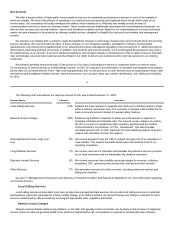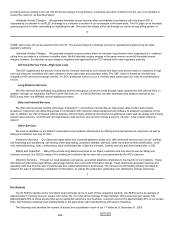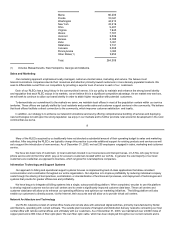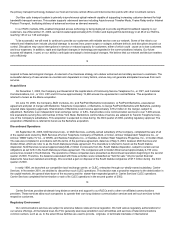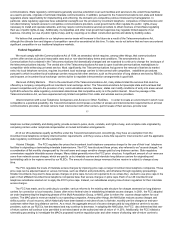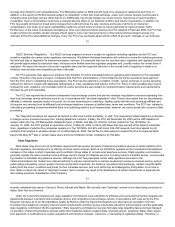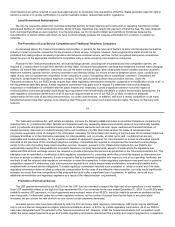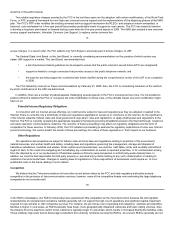FairPoint Communications 2003 Annual Report Download - page 14
Download and view the complete annual report
Please find page 14 of the 2003 FairPoint Communications annual report below. You can navigate through the pages in the report by either clicking on the pages listed below, or by using the keyword search tool below to find specific information within the annual report.
Net cash provided by operating activities of continuing operations $26,411 $44,706 $35,717 $55,632 $32,834
Net cash used in investing activities of continuing operations (59,986) (284,953) (57,161) (30,258) (54,010)
Net cash provided by (used in) financing activities of continuing
operations 46,979 300,088 101,234 (12,546) (1,976)
Net cash contributed (from) to continuing operations (to) from
discontinued operations (17,862) (64,466) (80,862) (10,353) 23,361
Cash $8,616 $3,991 $2,919 $5,394 $5,603
Property, plant and equipment 357,444 552,776 599,592 624,091 674,554
Property, plant and equipment, net 157,236 272,228 278,277 271,690 266,706
Total assets 517,356 863,547 875,015 829,253 843,068
Total long term debt 462,395 756,812 907,602 804,190 825,560
Preferred shares subject to mandatory redemption — — — 90,307 96,699
Total stockholders' equity (deficit) (11,581) 64,378 (149,510) (146,150) (147,953)
(1) On January 1, 2002, we adopted SFAS No. 142, "Goodwill and Other Intangible Assets." Pursuant to the requirements of SFAS No. 142, we ceased amortizing
goodwill beginning January 1, 2002, and instead test for goodwill impairment annually. Amortization expense for goodwill and equity method goodwill was
$5,335, $9,762 and $11,962 in fiscal 1999, 2000 and 2001, respectively. Depreciation and amortization excludes amortization of debt issue costs.
(2) Interest expense includes amortization of debt issue costs aggregating $1,575, $2,362, $4,018, $3,664 and $4,171 for the fiscal years ended December 31, 1999, 2000,
2001, 2002 and 2003, respectively. In 1999, interest expense includes $13,331 related to the retirement of put warrants of one of our subsidiaries. We prospectively
adopted the provisions of SFAS No. 150, "Accounting for Certain Financial Instruments with Characteristics of Liabilities and Equity," effective July 1, 2003.
SFAS 150 requires us to classify as a long-term liability our series A preferred stock and to reclassify dividends and accretion from the series A preferred stock as
interest expense. Such stock is now described as "Preferred Shares Subject to Mandatory Redemption" in the balance sheet and dividends and accretion on these
shares are now included in pre-tax income whereas previously they were presented as a reduction to equity (a dividend), and, therefore, a reduction of net
income available to common stockholders. In 2003, interest expense includes $9,049 related to dividends and accretion on shares subject to mandatory redemption.
(3) On January 1, 2001, we adopted the provisions of SFAS No. 133, "Accounting for Derivative Instruments and Certain Hedging Activities," as amended by SFAS
No. 138. On the date of adoption, the Company recorded a cumulative adjustment of $4,664 in accumulated other comprehensive income for the fair value of
interest rate swaps. Because the interest rate swaps do not qualify as accounting hedges under SFAS No. 133, the change in fair value of the interest rate swaps
are recorded as non operating gains or losses, which the Company classifies in other income (expense). We also recorded other
20
income (expense) in 2001, 2002 and 2003 for the amortization of the transition adjustment of the swaps initially recognized in accumulated other comprehensive
income. In the second quarter of 2002, we adopted SFAS No. 145 "Rescission of FASB Statements No. 4, 44, and 64, Amendment of FASB Statement No. 13 and
Technical Corrections." This statement eliminates the requirement that gains and losses from the extinguishment of debt be required to be aggregated and, if
material, classified as an extraordinary item, net of related income tax effect. In 2003, other income (expense) includes a $3,465 gain on the extinguishment of
debt and a $4,967 loss for the write-off of debt issue costs related to this extinguishment of debt.
(4) EBITDA means net income (loss) before income (loss) from discontinued operations, interest expense, income taxes, and depreciation and amortization. We
believe EBITDA is useful to investors because EBITDA is commonly used in the communications industry to analyze companies on the basis of operating
performance and leverage. We believe EBITDA allows a standardized comparison between companies in the industry, while minimizing the differences from
depreciation policies, financial leverage and tax strategies. EBITDA is also used in covenants in credit facilities and high yield debt indentures to measure a
borrower's ability to incur debt and for other purposes, and may be the preferred measure for these purposes. Covenants in our credit facility and the indentures
governing our senior subordinated notes and senior notes that limit our ability to incur debt are based on EBITDA. While providing useful information, EBITDA
should not be considered in isolation or as a substitute for consolidated statement of operations and cash flows data prepared in accordance with generally accepted
accounting principles. See "Item 7. Management's Discussion and Analysis of Financial Condition and Results of Operations—Liquidity and Capital Resources."
A reconciliation of net income (loss) to EBITDA follows (in thousands):
Net income (loss) $(29,040)$(89,117)$(211,600)$13,239 $1,671
(Income) loss from discontinued operations 10,085 73,926 186,178 (21,933) (9,921)
Loss from continuing operations (18,955) (15,191) (25,422) (8,694) (8,250)
Adjustments:
Interest expense(2)(3) 50,464 59,556 76,314 69,520 90,224
Provision (benefit) for income tax expense 2,179 5,607 431 518 (236)
Depreciation and amortization 29,964 46,146 55,081 46,310 48,089
EBITDA $63,652 $96,118 $106,404 $107,654 $129,827
(5) Total access line equivalents includes voice access lines and DSL.
(6) For purposes of determining the ratio of earnings to fixed charges, earnings are defined as earnings (losses) from continuing operations before income taxes,
minority interest and income or loss from equity investments, plus distributed income of equity investments, amortization of capitalized interest, and fixed
charges. Fixed charges include interest expense on indebtedness, capitalized interest and rental expense on operating leases representing that portion of rental
expense deemed to be attributable to interest. We had a deficiency to cover fixed charges of $16,583, $11,232, $24,906, $6,954 and $7,801 for the years ended
December 31, 1999, 2000, 2001, 2002 and 2003, respectively.
We are a leading provider of communications services in rural communities, offering an array of services, including local voice, long
distance, data, Internet and broadband product offerings. We are one of the largest rural telephone companies, and we believe that we are the
16th largest local telephone company, in the United States. We operate in 17 states with approximately 264,300 access line equivalents in
service as of December 31, 2003.


